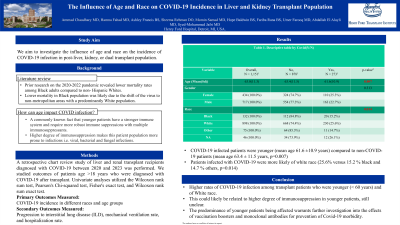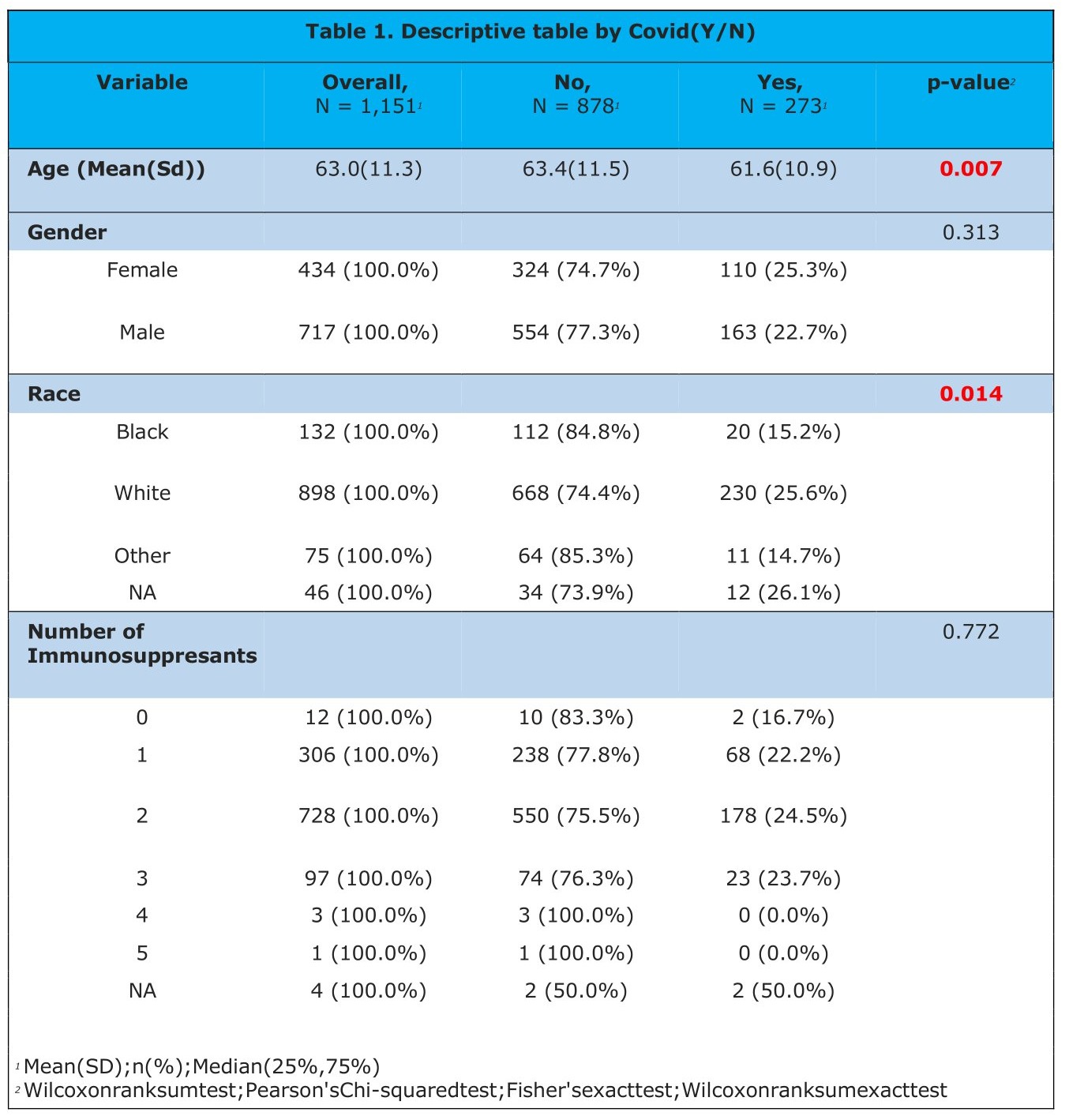Sunday Poster Session
Category: Liver
P0983 - Unveiling the Influence of Age and Race on COVID-19 Incidence in Liver and Kidney Transplant Population
Sunday, October 22, 2023
3:30 PM - 7:00 PM PT
Location: Exhibit Hall

Has Audio
- AC
Ammad J. Chaudhary, MD
Henry Ford Hospital
Detroit, MI
Presenting Author(s)
Ammad Chaudhary, MD1, Hamna Fahad, MD1, Ashley Francis, BS2, Momin Samad, MD3, Sheema Rehman, DO1, Hope Baldwin, 2, Fariba Rana, 2, Umer Farooq, MD4, Abdallah El Alayli, MD5, Syed-Mohammed Jafri, MD6
1Henry Ford Hospital, Detroit, MI; 2Wayne State University, Detroit, MI; 3Henry Ford Hospital, Rochester Hills, MI; 4Rochester General Hospital, Rochester, NY; 5Saint Louis University, St. Louis, MO; 6Henry Ford Health System, Detroit, MI
Introduction: Immunosuppression in solid organ transplant patients raises concerns for COVID-19 outcomes. Prior research on the 2020-2022 pandemic revealed lower mortality rates among Black adults compared to non-Hispanic Whites, likely due to the shift of the virus to non-metropolitan areas with a predominantly White population. Additionally, changes in vaccination rates and exposure also affect trends in age of infection. This study aims to emphasize racial and age-related disparities in COVID-19 incidence among transplant patients and compare these trends to previous studies on the general population.
Methods: This retrospective chart review study was conducted at a tertiary care center from 2022 to 2023. Adult patients (age > 18 years) who received Evusheld after liver, kidney, or simultaneous liver-kidney transplant were included. Demographics, disease characteristics, and outcomes were recorded in de-identified datasheets. The primary outcome measured was the incidence of positive COVID-19 PCR tests. Secondary outcomes included the progression to interstitial lung disease (ILD), mechanical ventilation rate, and hospitalization rate. Univariate analyses utilized the Wilcoxon rank sum test, Pearson's Chi-squared test, Fisher's exact test, and Wilcoxon rank sum exact test.
Results: Among 1151 solid organ transplant recipients, 273 (23.7%) were diagnosed with COVID-19 between the start of the pandemic and February 2023. COVID-19 patients were younger (mean age 61.6 ±10.9 years) compared to non-COVID-19 patients (mean age 63.4 ± 11.5 years, p=0.007). Specifically, patients aged 51-60 years had a significantly higher infection risk than those over 60 years old. Additionally, patients infected with COVID-19 were more likely of white race (25.6% versus 15.2 % black and 14.7 % others, p=0.014), and to not have received Evusheld (p< 0.001).
Discussion: Our data shows that COVID-19 infection rates were higher among transplant patients who were younger (< 60 years) and of White race. Whether this was related to higher degree of immunosuppression in younger patients, is unclear. The predominance of younger patients being affected warrants farther investigation into the effects of vaccination boosters and monoclonal antibodies for prevention of Covid-19 morbidity.

Disclosures:
Ammad Chaudhary, MD1, Hamna Fahad, MD1, Ashley Francis, BS2, Momin Samad, MD3, Sheema Rehman, DO1, Hope Baldwin, 2, Fariba Rana, 2, Umer Farooq, MD4, Abdallah El Alayli, MD5, Syed-Mohammed Jafri, MD6. P0983 - Unveiling the Influence of Age and Race on COVID-19 Incidence in Liver and Kidney Transplant Population, ACG 2023 Annual Scientific Meeting Abstracts. Vancouver, BC, Canada: American College of Gastroenterology.
1Henry Ford Hospital, Detroit, MI; 2Wayne State University, Detroit, MI; 3Henry Ford Hospital, Rochester Hills, MI; 4Rochester General Hospital, Rochester, NY; 5Saint Louis University, St. Louis, MO; 6Henry Ford Health System, Detroit, MI
Introduction: Immunosuppression in solid organ transplant patients raises concerns for COVID-19 outcomes. Prior research on the 2020-2022 pandemic revealed lower mortality rates among Black adults compared to non-Hispanic Whites, likely due to the shift of the virus to non-metropolitan areas with a predominantly White population. Additionally, changes in vaccination rates and exposure also affect trends in age of infection. This study aims to emphasize racial and age-related disparities in COVID-19 incidence among transplant patients and compare these trends to previous studies on the general population.
Methods: This retrospective chart review study was conducted at a tertiary care center from 2022 to 2023. Adult patients (age > 18 years) who received Evusheld after liver, kidney, or simultaneous liver-kidney transplant were included. Demographics, disease characteristics, and outcomes were recorded in de-identified datasheets. The primary outcome measured was the incidence of positive COVID-19 PCR tests. Secondary outcomes included the progression to interstitial lung disease (ILD), mechanical ventilation rate, and hospitalization rate. Univariate analyses utilized the Wilcoxon rank sum test, Pearson's Chi-squared test, Fisher's exact test, and Wilcoxon rank sum exact test.
Results: Among 1151 solid organ transplant recipients, 273 (23.7%) were diagnosed with COVID-19 between the start of the pandemic and February 2023. COVID-19 patients were younger (mean age 61.6 ±10.9 years) compared to non-COVID-19 patients (mean age 63.4 ± 11.5 years, p=0.007). Specifically, patients aged 51-60 years had a significantly higher infection risk than those over 60 years old. Additionally, patients infected with COVID-19 were more likely of white race (25.6% versus 15.2 % black and 14.7 % others, p=0.014), and to not have received Evusheld (p< 0.001).
Discussion: Our data shows that COVID-19 infection rates were higher among transplant patients who were younger (< 60 years) and of White race. Whether this was related to higher degree of immunosuppression in younger patients, is unclear. The predominance of younger patients being affected warrants farther investigation into the effects of vaccination boosters and monoclonal antibodies for prevention of Covid-19 morbidity.

Figure: Table 1.
Disclosures:
Ammad Chaudhary indicated no relevant financial relationships.
Hamna Fahad indicated no relevant financial relationships.
Ashley Francis indicated no relevant financial relationships.
Momin Samad indicated no relevant financial relationships.
Sheema Rehman indicated no relevant financial relationships.
Hope Baldwin indicated no relevant financial relationships.
Fariba Rana indicated no relevant financial relationships.
Umer Farooq indicated no relevant financial relationships.
Abdallah El Alayli indicated no relevant financial relationships.
Syed-Mohammed Jafri: Gilead, Takeda, Abbvie – Advisor or Review Panel Member, Speakers Bureau.
Ammad Chaudhary, MD1, Hamna Fahad, MD1, Ashley Francis, BS2, Momin Samad, MD3, Sheema Rehman, DO1, Hope Baldwin, 2, Fariba Rana, 2, Umer Farooq, MD4, Abdallah El Alayli, MD5, Syed-Mohammed Jafri, MD6. P0983 - Unveiling the Influence of Age and Race on COVID-19 Incidence in Liver and Kidney Transplant Population, ACG 2023 Annual Scientific Meeting Abstracts. Vancouver, BC, Canada: American College of Gastroenterology.
